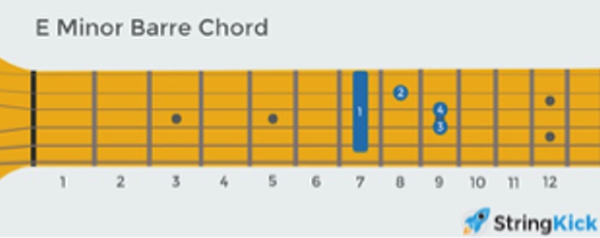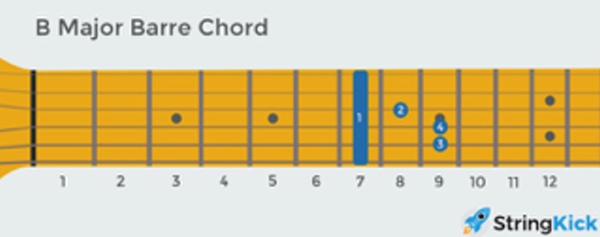Most guitarists struggle for a while before they finally master barre chords. They can be tricky to learn!
Ask for advice and you’ll often be told to ‘just practice more’, which isn’t particularly helpful.
Yes, it’s true that barre chords require practice, but there are a couple of pointers that can make them easier to learn.
In this article, I’ll share four practical tips that are often overlooked.
Beginner guitarists often arrive at barre chords after running into a song with an F chord. But the F barre chord is actually the most challenging one you could possibly try, for two reasons:
a. You have to barre over all six strings.
b. The closer to the nut you get, the harder you need to press to get a clean sound.
So, challenging as barre chords already are, I highly recommend you don’t start with an F barre chord. Instead, it makes much more sense to start with a five string barre chord, in seventh position (an E minor chord).

When you get comfortable with this chord shape, feel free to move it up and down the neck. Notice that playing it in first position (Bb minor) will be a little tougher!
The next step is to play a six string barre chord in seventh position, a B chord.

This will be slightly trickier because of the extra string you need to press. Again, move that chord up and down the neck and feel how every position is a bit different. You’ll notice that the F chord in first position requires you to press the hardest.
It’s only natural to place the flat face of your index finger on the strings to make a barre. But many guitarists prefer to ‘roll over’ their index finger a bit, and use the area in between the flat face and the side of their index finger. Using this part of your finger has a few advantages.
a. This part of your finger is a bit bonier and harder, making it easier to press down the strings.
b. If you use the flat face of your finger, strings might get caught in the tiny grooves between your phalanxes. This is less of a problem when you use the edge of your finger.
c. Using the edge of your finger, allows you to add a bit more pressure on the strings. It’s quite subtle, but in order to roll that finger onto its edge, your thumb and index finger will be applying pressure in opposite directions. Your index finger will be ‘pushing away’ towards the headstock of your guitar, while your thumb applies counterpressure.
All reasons of why this works aside, just give it a try!
When your barre chord doesn’t sound quite right, there’s often a simple way to fix it. Chances are some strings are exactly lined up with a crease in your finger. Try moving your index finger up or down a bit to change that. Many guitarists find that having their index finger sticking out above the fretboard a bit makes a big difference.
Using arm strength is a must for classical guitarists, because a classical, nylon-stringed guitar requires quite a bit of force to get that clean sounding barre chord. But for other guitarists it can also be a good way to reduce how hard your hand (and mostly your thumb) needs to work. Even the tiniest bit of arm strength can make a big difference.
So how does this work? First, you press the body of your guitar against your chest with your right arm (or left arm if you’re a lefty). You’re not squeezing the guitar – it’s more like a firm hug. Doing this will allow you to place pressure on the fretboard with your fretting hand, simply by pulling backwards with your left arm. This video provides a good explanation of how this technique works:
By using arm strength, you can even play barre chords without using your thumb at all! Of course, this isn’t a technique I’d recommend, but it shows you how powerful this tip can be. If you use just a little arm strength, you can give your thumb a much easier job.
Once you master barre chords, a world of possibilities opens up. When you learn how to move around barre chord shapes, you can play different types of chords in any key you like!
And by increasing your chord vocabulary, you can make your rhythm guitar playing sound much more interesting than only using open chords. Plus, barre chords are a great foundation for music theory, and will make it easier to learn about things like chord construction, guitar triads or different chord voicings. So while it might feel tough at times to learn barre chords, they’re very much worth the effort!
In this article, I covered some tips that are often overlooked. Once you get your technique right, you’ll find that barre chords will become much, much easier. Beyond that, it’s simple: practice!
Just Rijna is the founder of StringKick, a site focused on helping you learn the skills you need to explore your own taste and become the musician you want to be.